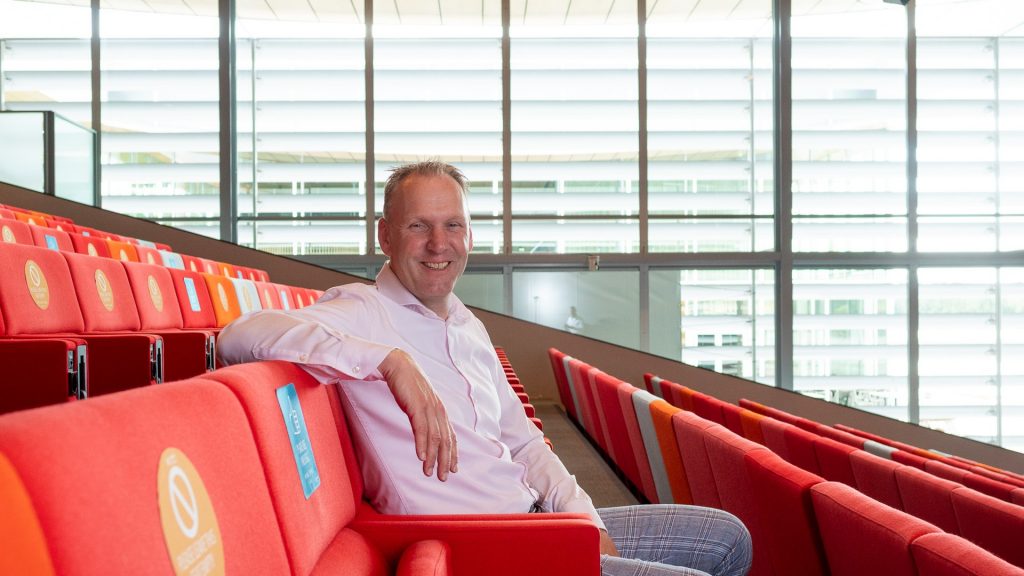Marc blogt: Digital twin: the great connector in building digitisation
Smart buildings are becoming increasingly common, but many of the opportunities offered by data-driven technology remain untapped due to inefficiencies. There is a growing need for a single digital reality, and this wish is close to being met by digital twins.
Everything from 1 platform
We’ve all been there. What’s that app called again? Where did I put that shortcut? You probably have anywhere between 30 and 50 different apps on your phone, all of which have different technical features and belong to different sources of information. All you really want is a combination of one or two apps, only to find that what you want just doesn’t exist. Right?
Untapped opportunities
There’s a similar problem in the world of facility management, where digital tools and methods, such as BIM, virtual reality, 5G and Internet of Things are growing at rapid pace. Together, they offer myriad new opportunities and a lot of new insight, increasing predictability, making it possible to simulate solutions before implementing them and providing more information to users.
However, to make the most of all these exciting new developments, all these applications have to be connected and retrieve data from one place. And that’s the challenge. The various systems in a building often work alongside each other, but not with each other. The data is stored in separate sources and is not made accessible. There is a lack of coordination, and many promising opportunities are left untapped as a result.

The digital twin is the solution
The solution to this is the digital twin. Although the words evoke the sense of a beautiful, almost complete digital copy of a building – which a digital twin can actually be -, the basic idea is rather more simple. In a digital twin, all information flows in the building first run to a central data platform, where the data are aggregated and forwarded to a solution tailored to the client.
A simple example is the coordination between maintenance, cleaning and staffing. Sensor information about building occupancy enters the digital twin, after which specific info is relayed to the organisations that provide maintenance or cleaning services. With that information, they can determine where there is more or less work to be done. In a more advanced incarnation, the building’s systems can automatically respond to the occupancy rate, changing temperature and light accordingly. Simply put, though, digital twins revolve around having a central repository of data that can be used for any number of purposes.
Of course, there are also more sophisticated digital twins: just look at what happens when you enrich a digital twin with 3D information from BIM. This would (quite literally) open up a whole new dimension of opportunities.
So how do a building’s stakeholders benefit from all these opportunties? We have found at least the following four advantages:
- Controlling the data
The main advantage of a digital twin is that the building owner gains control of all data. It eliminates the well-known problem of vendor lock-in, because a digital twin is linked to a building and is independent of service providers and manufacturers, including the maintenance and management contract. It is up to the building owner to decide who has access to the data.
- Optimal service
In an increasingly data-driven world, service providers and manufacturers can take advantage of a central repository containing data generated by sources other than their own. And that’s why the digital twin is such a promising development. Third parties can hone and improve their products or services based on the available data, paving the way for continuous improvement in any field: catering, cleaning, energy management or maintenance.
- Predicting and simulating
Predictability is a keyword in all things digital twin, as they make building performance and the corresponding costs increasingly predictable. What’s more, maintenance requirements will also become easier to predict, reducing the frequency of outages and increasing the lifespan of building systems. Adding 3D data retrieved from a BIM to a digital twin creates unprecedented opportunities to run simulations. Explore the effects of a renovation project in a virtual environment, or see exactly how the building will react to a heatwave and fine-tune your plans or systems to prevent any unwated consequences.
- Putting the user first
The broad applicability of data from the digital twin makes all kinds of new services possible, not only for the building manager, but also for the users themselves. Users care most about having a comfortable, healthy environment, and thanks to apps connected to the digital twin, users can get insight into and control over certain aspects of their workstation. Users can also use these apps to interact with the building, e.g. by booking a parking space, booking a room, and more. Besides, user feedback can help improve the building’s performance and the workplace.
In short: the digital twin is the ideal stepping stone as we inch ever closer to a fully digitised future and offers plenty of added value for the entire chain: from building owners and managers to chain suppliers and users.

Source: This blog was also published on Duurzaam gebouwd.
Share Message
See also

PULSE Core gives Nimeto students insight into sensor technology
PULSE Core is part of the teaching material of MBO vocational school Nimeto in Utrecht. There are 10 sensors in various rooms in the school

Healthy Work Environment? Achieve this goal together with PULSE Core!
In the modern business world, creating a healthy work environment plays an important role in promoting both employee productivity and overall well-being. Facility managers and
